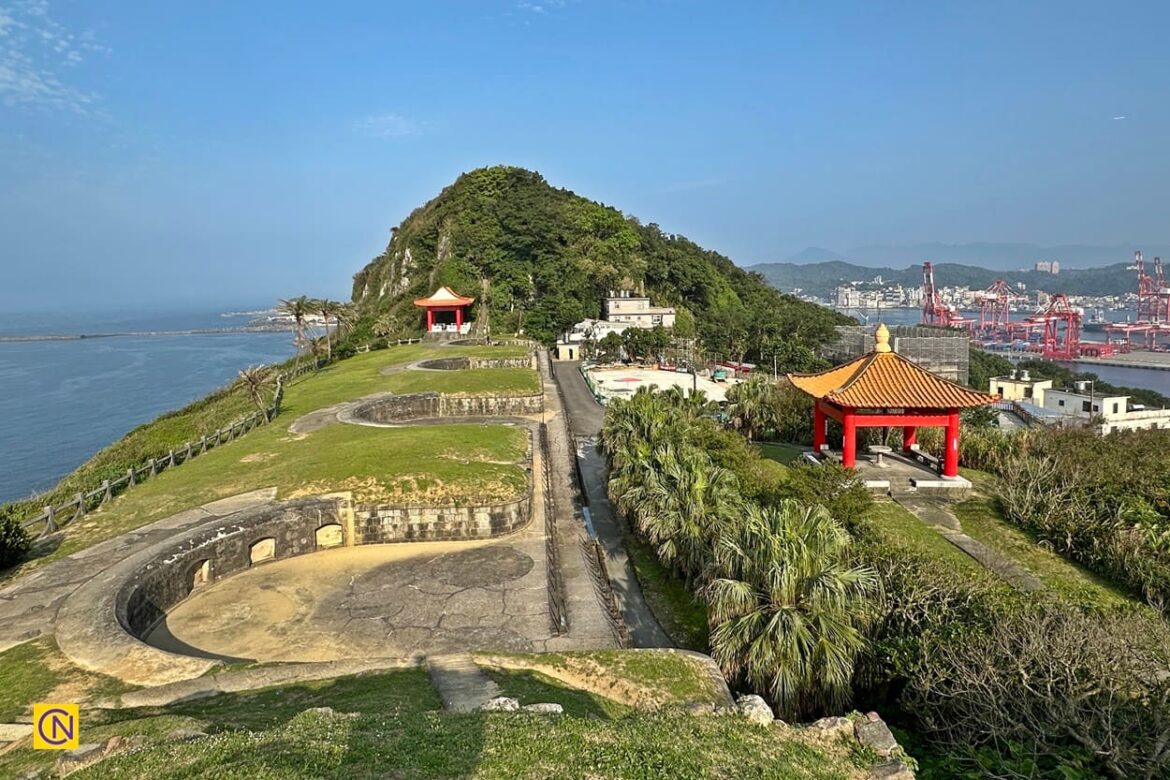Baimiweng Fort (白米甕砲台), also known as Holland Castle, is located at the forefront of the left wing of Keelung Port in northern Taiwan. Built on a series of terraces about 70 meters (229.6 feet) above sea level, It is a testament to Taiwan’s rich military history and strategic significance and offers stunning views of the Keelung Port and other surrounding landscapes.

A brief history of Baimiweng Fort
The name Baimiweng translates to “White Rice Urn (白米甕),” a reference to the white rice once cultivated in the area. The fort is believed to have been constructed over 300 years ago during the Spanish and Dutch occupations, which is why it is also known as Holland Castle. It was also briefly occupied by French forces during the Sino-French War.
For more fascinating visuals and insights, watch the following video: “Exploring Keelung’s Baimiweng Fort: A Hidden Coastal Fortress.”
The current structure, however, was built during the Japanese colonial era as a defense post against Russia during the Russo-Japanese War. The Japanese government later renovated the fort in 1927 and expanded it further in 1931.
After the Republic of China (ROC) took over Taiwan, the fort was decommissioned in 1957. Between 1980 and 2021, it underwent extensive restoration. During this time, hiking trails were developed to link the fort with nearby landmarks, including Chiutzushan Lighthouse, located approximately 1,500 meters (4,921 feet) away, and Keelung Lighthouse, just 500 meters (1,640 feet) from the fort.

The Ministry of the Interior classified Baimiweng Fort as a Grade III monument on August 19, 1985. On October 13, 2009, it was declared a Keelung City Monument. It is now open to the public free of charge.

Features of Baimiweng Fort
Perched atop terraced hills, Baimiweng Fort occupies a highly strategic location that offers sweeping, unobstructed views of the entrance of Keelung Port. This elevated position made it an ideal vantage point for monitoring maritime traffic, detecting incoming ships, and coordinating coastal defense operations. The fort’s placement highlights its crucial role in protecting Keelung’s coastline throughout various periods of foreign occupation and military conflict.

Baimiweng Fort is primarily constructed from stone and brick, featuring thick, sturdy walls designed to withstand artillery fire. One of its most distinctive features is its unique layout: the command post, four artillery mounts, and the observation post are all aligned in a straight row from left to right, each strategically facing the open sea. This design maximized the fort’s defensive capabilities and provided a transparent, continuous line of sight for monitoring and responding to potential maritime threats.
In addition to the four gun mounts in the cannon platform area, Baimiweng Fort also features a range of military facilities, including barracks, warehouses, an ammunition depot, officers’ quarters, a water reservoir, and guard posts. These well-preserved structures offer a compelling glimpse into the era’s military architecture and daily life.

The beauty of Baimiweng Fort
The lawn in front of the four artillery mounts is an elevated vantage point, offering breathtaking panoramic views of the vast Pacific Ocean, with Keelung Islet visible in the distance. Visitors can also take in the Hsieh-ho Power Plant, with its three towering chimneys, the Guanghua Tower, Keelung Harbor, and the lush green mountains.

The scenery is especially captivating at sunrise and sunset, when the sky is bathed in vivid colors. This attracts photographers, sightseers, and nature lovers eager to soak in the tranquil beauty and capture the perfect moment.

The fort is flanked by Chiutzushan Lighthouse and Keelung Lighthouse, each located on opposite sides and connected by scenic trails. In 1956, Chiutzushan Lighthouse was the first lighthouse in Taiwan, which was designed and constructed entirely by Taiwanese engineers. It is one of only two rectangular lighthouses in Taiwan, the other being Su’ao Lighthouse.

Keelung Lighthouse, originally built in 1900 during the Qing Dynasty and renovated in 1962, continues to guide maritime traffic, symbolizing Keelung‘s enduring significance as a port city. A short walk from the fort leads visitors to this operational lighthouse, adding another layer to the area’s rich historical landscape.

Another iconic landmark of the port is Guanghua Tower, a striking blue, umbrella-shaped lighthouse standing approximately 33.5 meters tall. Completed in 1967, it was initially reserved exclusively for the Port Authority to receive VIPs and remained closed to the public due to security concerns. It wasn’t until 2000 that the tower was transformed into Taiwan’s first circular, lighthouse-style restaurant, offering a stunning 360-degree view of the surrounding seascapes, including Keelung Islet and Keelung Port.

Although it is currently closed to the public, visitors can still admire Guanghua Tower up close by taking a ferry cruise around Keelung Harbor. A round-trip ticket from the harbor to the tower costs NT$250 for adults and NT$150 for children, with the journey taking approximately 20 minutes.
Follow us on X, Facebook, or Pinterest

